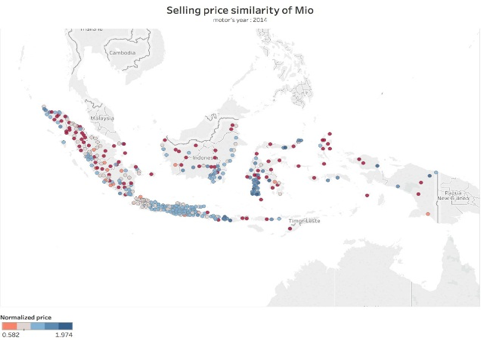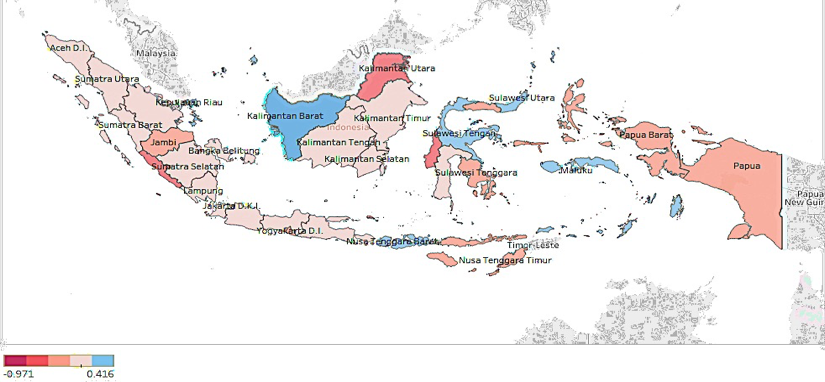Trade and Competitiveness
As the fourth industrial revolution continues to create new industries as well as transform legacy sectors, it is important for Indonesia to acquire more sophisticated productive capabilities. Opportunities abound for access to new markets and for accelerated economic growth, should businesses invest in technological learning. Accordingly, the Indonesian Government aims to promote trade and investment, to increase efficiency and transparency, to provide a supportive digital innovation ecosystem, and to enhance logistics competitiveness. To foster digital transformation, it is important to collaborate with a broad category of stakeholders.
Pulse Lab Jakarta, in collaboration with OLX Indonesia, is organizing a research event, Research Dive for Development: Trade and Competitiveness. We hope to make a contribution to this cause by enhancing the familiarity of researchers with alternative datasets, as well as sourcing insights on maritime infrastructure improvements, trade connectivity, and e-commerce. The event took place from 6th to 9th August 2017 at the Pulse Lab Jakarta office.
The four sub topics of the fourth Research Dive are:
- Task 1 - Analysis of port network connectivity, national or ASEAN-wide, using global marine vessel automatic identification system data
- Task 2 - Analysis of inter-city connectivity in Indonesia, using e-commerce data
- Task 3 - Analysis of proxies in e-commerce data for city-level and national economic trends and shocks
- Task 4 - Analysis of correlations between postal network data and trade network data within ASEAN
The information package of the fourth Research Dive is accessible here: bit.ly/infopackage-RD4
Group 1: Analyzing Port Connectivity in South-East Asia using Global Marine Vessel Automatic Identification System Data
Abstract
Maritime transport plays a critical role in economic development for the littoral member states of the Association of Southeast Asian Nations (ASEAN). In the era of big data, the global marine vessel automatic identification system (AIS) is an important instrument for analyzing the maritime transport network. Aligned with this potential, the Government of Indonesia (GoI) envisions a greater role for the country as the global maritime axis, by setting up several maritime development plans, including "Tol Laut". This study aims to analyze current port connectivity in South-East and East Asia and the further integration of the existing network under the Tol Laut development plan. We use two approaches: betweenness centrality and network efficiency. Betweenness centrality analysis suggests that Tol Laut could reduce ASEAN maritime transport dependency on Singapore. The network effciency analysis suggests that should Bitung became a hub port in Eastern Indonesia, it would lead to a 20% increase in network efficiency when compared to the status quo, as well as when compared to the model for Sorong as a hub port.
Result
The research confirms the common perception that a lack of connec- tivity between Eastern Indonesia and East Asia exists. Based on the betweenness centrality, the implementation of Tol Laut can reduce network dependency on Singapore by 8% and on Tanjung Priok by 24%.

Chord diagram of O/D matrix from AIS data
This suggests that successful implementation of the Tol Laut master plan should have the effect of balancing the maritime network within Indonesia. In terms of network efficiency, when Bitung becomes a hub port for Eastern Indonesia, as foreseen by Tol Laut, the study suggests that this should lead to an increase in efficiency by 20% when compared to the current network and Scenario 2 which models Sorong as the hub port. This confirms the relevance of Tol Laut to Indonesia’s broader economic development agendas.sh
Group 2: E-Commerce Based Regional Connectivity in Indonesia
Abstract
Rapid deployment of e-commerce which over the last two decades led to the emergence of a number of factors which related to buying decision and market orientation from both customer’s and seller’s perspectives. This affected not only for the new brand products but to the used or second-hand ones as well. As e-commerce is characterised by borderless trading between and among regions, it also spurred inter-connectivity among regions. Drawing from the idea of utilising big data for addressing whether or not e-commerce spurs inter-city connectivity, this research investigates sellers’ preferences to measure customers’ willingness to purchase using price uniformity as proxy. Employing statistical methods to measure standard deviation of the secondhand products, the study found that price uniformity could be utilised to indicate whether inter-connectivity exists in classiffied ads. The finding implies that price uniformity is useful in contributing to the decision-making pro- cesses of policy concerning e-commerce and could be applied to other commodities as well.
Result
From this research, we can conclude that price uniformity can be used as proxy to indicate the inter-city (inter-region) connectivity. By looking at the data of Avanza and Mio ads, most areas in Indonesia still have low connectivity inside and outside the city. The government can use the connectivity map in this research to develop the issue of inter-city (inter-region) connectivity in Indonesia.

Price Distribution of Yamaha Mio
We also argue that this research will be more suitable if we use other products that have more homogenous price as proxy for measuring inter-city connectivity, such as food commodities. Moreover, the result can be refined if we are able to use new product rather than secondhand product and obtain the origin-destination (O-D) data of e-commerce product sales. We recommend that these improvements should be tailored into our method and implemented as future research.
Group 3: Constructing Proxies of Macroeconomic Trends Using E-Commerce Data
Abstract
We explored possible proxies of economic growth using an e - com- merce data provided by olx.co.id. Data used in this research was data from 2016 and 2017 city and provincial levels after being ad- justed. We constructed three proxies of macroeconomic trends by taking advantage of three main olx’s main markets: car, motorcycle, and property. Two proxies were developed to see income and consumption smoothing. One proxy was constructed to see the direction of economic growth at city and province level. We also captured social proxy at the different territory of common goods purchased in three main markets at the city and municipality level with dummy regression.
Result
In this research, we had three findings. First, the sale of e-commerce will encourage the purchase of goods that can increase GDP growth indirectly through consumption. Second, calculation on sell-rent ratio addressed several provinces outside main island Java are experiencing upward economic growth, while Java, in general, is experiencing mild downturn. Third, urban consumers prefer to buy a car, motorcycle, property than municipality consumers. This is possibly the cause of traffic jam in the city meanwhile road area is limited. We recommend an increase in luxury goods and sales taxes for controlling car purchases and re-evaluation of LTV (loan to value) rate for affordable housing prices.

Sell-Rent Price Ratio Overtime Aggregated at Province Level
Group 4: Analysis of Correlations between Postal and Trade Network Data within ASEAN Countries and Beyond
Abstract
This study mainly examines the correlation between Postal Network Data (PND) and Trade Data within ASEAN countries and beyond. In addition, based on the previous study on the global network structure, including postal network, as proxies for national well- being, we also assess how the PND can affect the other recent socioeconomic indicators among ASEAN countries.
Result
This study found that Singapore dominates both the postal and trade networks in ASEAN. There are high correlations between flows/networks data.(i.e.,PND and trade). Also, there are high correlations between postal network data and socio-economics indicators, trade network data and socio-economics indicators.

Correlation between Post to and Post from Data with socio-economic indicators
Further study to investigate the causal relationship between flows/networks data especially between postal network data and the socio-economics indicators can be conducted. A study on comparing the postal newtork data and trade data with other flows/networks, such as migration, flights, shipping, would be also valuable, to gain more insights on the context of the inter-connectivity that has been generated.
Advisors
| Titik Anas | Australia Indonesia Partnership for Economic Governance (AIPEG) |
| Teguh Dartanto | Universitas Indonesia |
| Yudo Anggoro | Institut Teknologi Bandung |
| Rossanto Dwi Handoyo | Universitas Airlangga |
Participants
Group 1 – Analysis of port network connectivity, national or ASEAN-wide
| Hafida Fahmiasari | World Bank |
| Budhi Sholeh Wibowo | Universitas Gajah Mada |
| Chairullah Amin | Universitas Khairun |
| Silvia Merdikawati | Institut Teknologi Indonesia |
| Dwi Kristianto | Institut Teknologi Sepuluh Nopember |
| George Hodge | Pulse Lab Jakarta |
Group 2 – Analysis of inter-city connectivity in Indonesia
| Siti Nurminarsih | Universitas Internasional Semen Indonesia |
| Khresna Bayu Sangka | Universitas Sebelas Maret |
| Tengku Munawar Chalil | Osaka University |
| Doddy Iskandar | Universitas Gajah Mada |
| Oryza Kusumaning Ayu | OLX Indonesia |
Group 3 – Analysis of proxies in e-commerce data for city-level and national economic trends and shocks
| Ahmad Syarif | Universitas Gajah Mada |
| Grace Citra Dewi | Centre for Strategic and International Studies (CSIS) |
| Ilwa Nuzul Rahma | Universitas Indonesia |
| Riska Pujiati | Kementerian Perdagangan Indonesia |
| Hervind | OLX Indonesia |
Group 4 – Analysis of correlations between postal network data and trade network data within ASEAN
| Rezzy Eko Caraka | Bina Nusantara University |
| Nurrohman Wijaya | Institut Teknologi Bandung |
| Muhammad Mujiya Ulkhaq | Universitas Diponegoro |
| Putu Mahardika Adi Saputra | Universitas Brawijaya |
| Muhammad Subair | Pulse Lab Jakarta |
